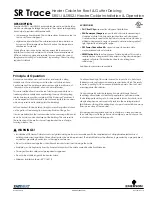
Principle of Operation
As snow accumulates on a roof in winter, inadequate ceiling
insulation and/or roof venting can allow the roof surface above
heated areas of the building to get warm enough to melt some of
the snow on the roof surface, even on cold winter days.
This water will then flow down the roof and may accumulate and
freeze in gutters, possibly even overflowing them and forming long
icicles. (Icicles are usually a symptom of this “warm roof” problem. It
can be expected that roofs with icicles will eventually form ice dams
which may result in water leaking into the building.)
Left unchecked, this ice build-up (icing) can result in significant stress
on the gutter, often leading to mechanical failure of the gutter.
It is also probable that the roof area above the overhang will be cold,
since it is not above a heated area of the building. This can result in
the re-freezing of the melt-water as it approaches the roof edge,
forming a layer of ice.
Continued freezing of this water causes the layer of ice to build up in
thickness and eventually can become several inches thick. This results
in water “ponding” at the warm/cold transition point of the roof, and
migrating under the shingles.
Once water gets under the shingles, it can leak through the roof
sheathing, at nail holes or other roof penetrations, and down inside
the building walls, ceiling, etc. It is also possible for such water to track
along ceiling beams and eventually leak into the building interior at
light fixtures or through the ceiling finish at a point some distance away
from the location of the ice dam.
By applying heating cable from the roof edge to a level just above
the overhang, and in the gutter and downspouts, melt-water on the
roof will have a clear drainage path.
©2015 EasyHeat
www.easyheat.com
14031-001 Rev. 10
Heater Cable for Roof & Gutter Deicing
SR51J & SR52J Heater Cable Installation & Operation
DESCRIPTION
Easy Heat’s SR51J and SR52J heater cables prevent ice dam build-up
which can damage buildings and gutters. The cables’ self-regulating
heat output provides additional benefits:
• Lower energy consumption. The cable reduces its power output as
the ice and snow disappear.
• High temperature limited. The cable reduces its temperature as
it warms, so this minimizes the effect of heat on the temperature
sensitive roof materials.
Use only Easy Heat connection and accessory kits to ensure your
installation is safe and conforms with electrical code requirements.
SR Trace cables are generally suitable for use on asphalt or wood
shingles, metal roofing or “membrane” type roofing. Consult roofing
supplier for details.
SR Trace
ACCESSORIES
• ZH-C Roof Clips are used for all types of installations.
• DSH Downspout Hangers support the heater cable descending a
downspout drain. One hanger is required for each downspout.
Cable must be looped to the bottom of downspout and back up,
utilizing a downspout hanger to prevent cable from being pulled
tight against the drain/gutter edge.
• SRP Power Connection Kit connects power to heater cable
and terminates tail end of cable.
• SRSRG Splice Kit splices two pieces of cable together. This may be
required when a longer circuit is needed or to repair a damaged
segment of cable. (Plan splice location to avoid long-term
submersion.)
Additional accessories are available.
WARNINGS!
• Installation of SR Heater Cable for roof and gutter deicing must be in accordance with the requirements of all applicable electrical and
building codes and regulations. Ground-fault protection must be provided. The braid shield must be effectively grounded by a properly-sized
equipment grounding conductor or other approved means.
• Do not twist bus wires together – this will result in a short circuit and damage the cable.
• Moisture must be kept away from the live electrical parts of the cable or electrical faults will develop.
• Damaged heater cables must be repaired or replaced.
• Do not place ladders against the heater cable.
• Minimum Installation Temp: -40°C (-40° F).























